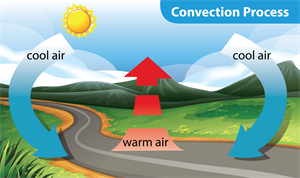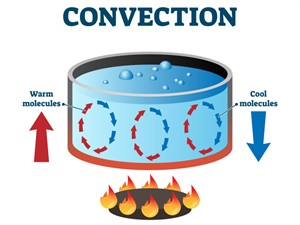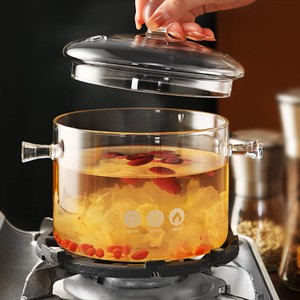After feeling the heat from the metal handle bar, you start riding your bicycle. As the wind blows against your sweaty face and arms, you suddenly feel cooler. This happens even though the Sun is still shining.
What is happening here?
- While cycling, your body produces heat due to physical activity. So your skin releases heat, warming the air around it.
- As you move forward cooler air flows over your body carrying away the warm air near your skin.
- From the body, more heat transfers to the cooler air. This removes heat from your body, making you feel cool.
- The heat is transferred by the movement of air which is a fluid.

Movement of air
Later that day, you get home and smell delicious food even before reaching the kitchen.
What is happening here?
- While cooking, the air near the hot food gets heated and becomes lighter.
- This warm air which is lighter rises up, carrying the aroma with it.
- Cool air which is heavier, moves in to replace it from the surroundings.
- This causes a circular movement of air - hot air up and cool air down.
What do both these situations have in common?
In both the cases, heat and smell is transferred through one of the processes of heat transfer called convection.
Convection:
Convection is the process where heat is transferred from one place to another through gas and liquid due to the actual movement of particles, as hot air moves upward and cool air downward.

Convection
Example:
- Boiling water - The cold, dense molecules from the top sink to the bottom, while hot, lighter molecules from the bottom rise up creating a circular motion that heats the water evenly.
- The formation of land and sea breeze is due to convection of air.
-
Wind flows from one region to another region by convection.
-
In warm-blooded animals, blood circulation takes place with the help of convection which helps to maintain the body temperature.
-
In hot air balloons, heat is transferred by convection, and so the balloon rises.
-
In refrigerators, cool air moves downward and replaces the hot air because of convection.
Activity:
To observe and understand how heat is transferred in liquids through convection by watching the movement of particles.

Boiling water with grains
Important!
Caution: This activity should be performed under adult supervision.
Step 1: Take water in a transparent container.
Step 2: Drop in small grains or pasta.
Step 3: Heat the container now to boil the water.
Step 4: Watch carefully how the grains start to rise upwards from the bottom.
Explanation:
When the container with the water and grains is heated, the water at the bottom gets heated first. As this water gets hotter, it becomes less dense, lighter and starts to rise up bringing the grains together to the top.
At the same time, the cooler, high dense and heavier water at the top, sinks down to replace the heavier hot water. This circular flow forms convection current.
Food for thought:
Why is the freezer mostly placed at the top of the refrigerator? Would it function if the freezer is kept at the bottom?
Reference:
https://m.media-amazon.com/images/I/71eVUrqdB9L.jpg